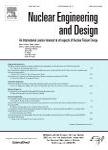版权所有:内蒙古大学图书馆 技术提供:维普资讯• 智图
内蒙古自治区呼和浩特市赛罕区大学西街235号 邮编: 010021

作者机构:Univ Paris Saclay CEA DES ISAS DM2SSGLSLIAD F-91191 Gif Sur Yvette France Inst Math Toulouse UMR5219 CNRS F-31062 Toulouse France eXalt 19 Rue Amiens F-59800 Lille France Univ Paris Saclay CEA DES ISAS DM2SSTMFLATF F-91191 Gif Sur Yvette France
出 版 物:《NUCLEAR ENGINEERING AND DESIGN》 (核工程与设计)
年 卷 期:2023年第413卷第1期
核心收录:
学科分类:08[工学] 0827[工学-核科学与技术]
基 金:NEEDS pro-gram
主 题:Uncertainty quantification Multi-group CIRCE ECME algorithm Thermal-hydraulic system codes Critical mass flow
摘 要:The semi-empirical nature of best-estimate models closing the balance equations of thermal-hydraulic (TH) system codes is well-known as a significant source of uncertainty for accuracy of output predictions. This uncertainty, called model uncertainty, is usually represented by multiplicative (log-)Gaussian variables whose estimation requires solving an inverse problem based on a set of adequately chosen real experiments. One method from the TH field, called CIRCE,2 addresses it. We present in the paper a generalization of this method to several groups of experiments each having their own properties, including different ranges for input conditions and different geometries. An individual (log-)Gaussian distribution is therefore estimated for each group in order to investigate whether the model uncertainty is homogeneous between the groups, or should depend on the group. To this end, a multi-group CIRCE is proposed where a variance parameter is estimated for each group jointly to a mean parameter common to all the groups to preserve the uniqueness of the best-estimate model. The ECME algorithm for Maximum Likelihood Estimation developed in Celeux et al. (2010) is extended to the latter context, then applied to relevant demonstration cases. Finally, it is tested on a practical case to assess the uncertainty of critical mass flow assuming two groups due to the difference of geometry between the experimental setups.